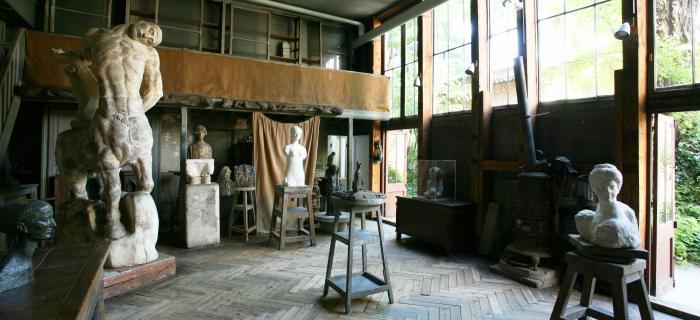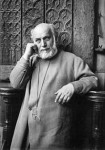

Antoine Bourdelle
French, 1861-1929
The Dying Centaur, 1914, after
bronze in the lost wax method / Rudier cast ed.10
32 × 16 in.
SBMA, Gift of Wright S. Ludington
1945.6.2

Antoine Bourdelle, 1925. Above: The sculpture studio has surprisingly remained in its original state. The high glass roof, opened to the even, cold northern light, the mezzanine that allows one to look at the works from different angles, and even the walls, in the "colours of the time"...nothing has changed. The stove, the large wooden table assembled by Bourdelle's father and the tumtables are still in their original positions. The antique style moulds, the Samourai armour and the medieval capital acting as a stand were all part of the artist's environment. Guarded by the Centaure mourant (Dying Centaur), (1911-1914), a range of works in wood, marble and bronze offers a summary of Bourdelle's studies and shows the diversity of the materiels and techniques he used. Everything speaks to us eloquently and sensitively of the master's presence. Everything tells of the silence, meditation and labour of this "spiritual home", so near and yet so far from the hustle and bustle of Montparnasse. - See more at: www.bourdelle.paris.fr/en/bourdelles-studio
RESEARCH PAPER
Bourdelle's Artistic Influences and Legacy
Bourdelle was born in the village of Montauban, the birthplace of Ingres. His father was a furniture maker, his uncle a stone mason. As a child Bourdelle herded goats, amusing himself by carving wood and modeling clay figures. At thirteen he left school to work as an ornamental carver in his father’s business. These early experiences, as well as the local, stony countryside rich in Romanesque ruins, influenced his later work as a sculptor. At fifteen Bourdelle entered the Toulouse School of Fine Arts. Ten years later he studied with Falguiere at the Ecole des Beaux-Arts in Paris, leaving there after two years to study with Dalou.
In 1893 Bourdelle met Rodin, resulting in a fifteen year association which included working as one of Rodin’s chief marble carvers and advisors and establishing with him a free school for sculptors. Rodin spoke of Bourdelle as "a beacon of the future." An influential teacher until the end of his life, Bourdelle’s notable students included Richier, Giacometti, and Matisse. Bourdelle’s work is "divided between two tendencies . . . so different as to appear contradictory." The first, lasting into the first decade of the 1900s, strongly reflected the expressive influence of Rodin. His later work, presaged in The Head of Apollo (SBMA 1993.1.28) evolved away from Rodin into a style of constructing in planes, reminiscent of 12th century stone cutters and anticipating cubist sculptors such as Picasso and Lipschitz. His finest work reflects archaic Greek and Gothic influences. Bourdelle is today best remembered for his monumental sculptures such as the equestrian bronze Alvear (1925). In 1949 the Muse Bourdelle was established in Montparnasse to celebrate his life and work.
Prepared for the Santa Barbara Museum of Art Docent Council by Mary Eckhart—March 2001.
SBMA CURATORIAL LABELS
This dying centaur, a creature half-human and half-horse, conveys a sense of invincible strength and heart-wrenching vulnerability all at once. Viewing the piece from different angles reveals diverse aspects of the centaur’s inner struggle: his right arm actively supports his lyre, right hand pointing upwards, while his left arm has fallen limp, echoing the angle of his head, which has slumped sharply onto his left shoulder. The centaur as musician and poet stands for the artist’s struggle with one’s humanity - one half entrenched in the carnal world, the other in the realm of inspiration.
- Sculptures that Tell Stories, 2019
This sculptural idea was conceived by Bourdelle at the height of his powers, after his break with his mentor Rodin and during the most fecund period of his career. At the time of its creation, Bourdelle was also undertaking several other ambitious public monuments and was very active as a teacher to younger, aspiring artists like Germaine Richier and Giacometti. The narrative kernel derives from Greek myth—in this case, the story of the last centaur, Chiron, who was accidentally wounded by one of Hercules’ poison arrows and granted his wish for death by the Gods to end his suffering. However, the anguish of the centaur’s body, in contrast with the serene acceptance of his facial expression, symbolizes the same universality of willing self-sacrifice associated with traditional representations of Christ’s passions. As such, the sculpture personifies the sublime victory of mind over body, intellect over the passions.
- Rodin and His Legacy, 2017
